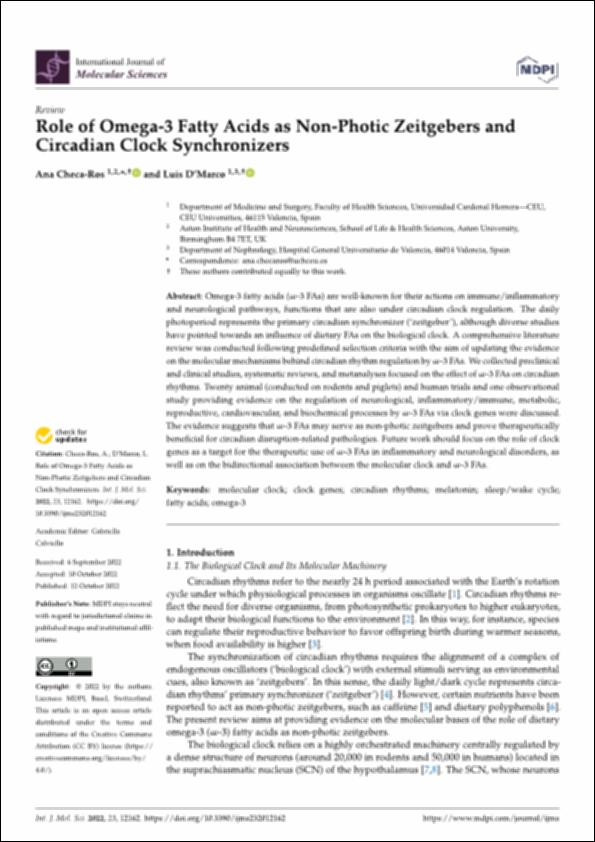Por favor, use este identificador para citar o enlazar este ítem:
http://hdl.handle.net/10637/14387Role of Omega-3 fatty acids as non-photic zeitgebers and circadian clock synchronizers
| Título : | Role of Omega-3 fatty acids as non-photic zeitgebers and circadian clock synchronizers |
| Autor : | Checa Ros, Ana D'Marco Gascón, Luis Gerardo |
| Materias: | Circadian rhythms.; Biorritmos.; Biological rhythms.; Melatonin.; Fatty acids.; Ritmos circadianos.; Melatonina.; Ácidos grasos. |
| Editorial : | MDPI |
| Citación : | Checa-Ros, A. & D'Marco, L. (2022). Role of Omega-3 fatty acids as non-photic zeitgebers and circadian clock synchronizers. International Journal of Molecular Sciences, vol. 23, i. 20 (12 oct.), art. 12162. DOI: https://doi.org/10.3390/ijms232012162 |
| Resumen : | Omega-3 fatty acids (!-3 FAs) are well-known for their actions on immune/inflammatory and neurological pathways, functions that are also under circadian clock regulation. The daily photoperiod represents the primary circadian synchronizer (‘zeitgeber’), although diverse studies have pointed towards an influence of dietary FAs on the biological clock. A comprehensive literature review was conducted following predefined selection criteria with the aim of updating the evidence on the molecular mechanisms behind circadian rhythm regulation by!-3 FAs. We collected preclinical and clinical studies, systematic reviews, and metanalyses focused on the effect of!-3 FAs on circadian rhythms. Twenty animal (conducted on rodents and piglets) and human trials and one observational study providing evidence on the regulation of neurological, inflammatory/immune, metabolic, reproductive, cardiovascular, and biochemical processes by !-3 FAs via clock genes were discussed. The evidence suggests that !-3 FAs may serve as non-photic zeitgebers and prove therapeutically beneficial for circadian disruption-related pathologies. Future work should focus on the role of clock genes as a target for the therapeutic use of !-3 FAs in inflammatory and neurological disorders, as well as on the bidirectional association between the molecular clock and !-3 FAs. |
| Descripción : | Este artículo se encuentra disponible en la siguiente URL: https://www.mdpi.com/1422-0067/23/20/12162 Este artículo de investigación pertenece al número especial "Molecular Research in Circadian Rhythm and Cellular Synchrony". |
| URI : | http://hdl.handle.net/10637/14387 |
| Derechos: | http://creativecommons.org/licenses/by/4.0/deed.es |
| ISSN : | 1422-0067 (Electrónico) |
| Idioma: | es |
| Fecha de publicación : | 12-oct-2022 |
| Centro : | Universidad Cardenal Herrera-CEU |
| Aparece en las colecciones: | Dpto. Medicina y Cirugía |
Los ítems de DSpace están protegidos por copyright, con todos los derechos reservados, a menos que se indique lo contrario.


